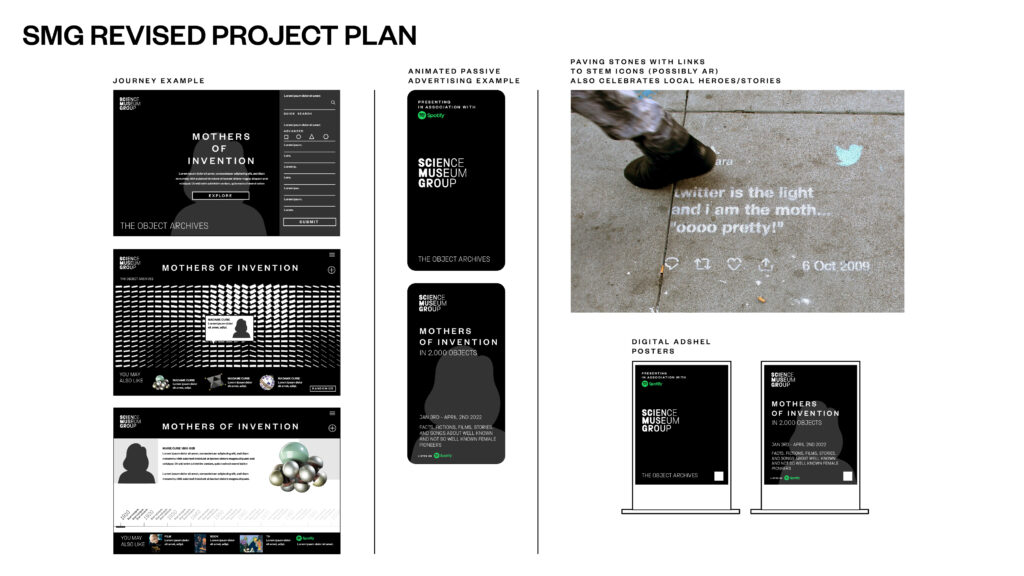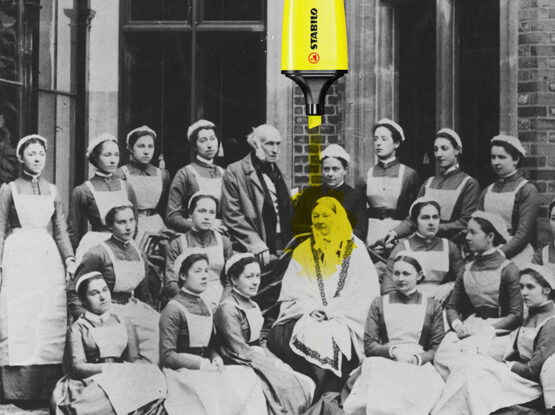Methodologies for thinking and development processes
REFLECTIONS ON LECTURE AND SOURCE MATERIALS
—
LECTURE
Please describe a case study when innovative design thinking and fresh insight enabled a surprising project outcome.
In talking about their individual projects the lecturers shed light on issues that I have encountered in my own practice. Torsten touched on the hierarchy within an organisation affecting the the final outcome because you are not necessarily dealing with the person that will ultimately sign off on a given project. He refers to this as a failure but I would not say that this is necessarily incumbent on the design team and that client organisations themselves need to provide more access so you are talking to the right people. Having new knowledge from the CEO they were able to review their design strategy and the result was surprising and new as they chose not to use restrictive systems but create their own. Torsten also made the point that if you are led in the wrong direction you need to question whether it is a good idea or not and fight not to go with the 'bad' suggestion. Wouter Dirks of Studio Dunbar also touches on this and in questioning the university brief they came to a solution that wasn't just a logo but a reflection of the creative science campus. This led them to a surprising outcome that was unique to the university.
Matthew of A+P talks about the hidden 'secrets' they like to include in their work which are discovered and create their own narratives. This is a clever way to add an extra layer of engagement to a project. Stijn van der Ven of Eden Spiekermann found an approach in reframing the question of the given brief and coming to a solution by asking a series of questions regarding the brands values. He talked about getting to the heart of the meaning of individual things which in turn creates emotional connections and engagement for the audience. All of the lecturers base their process on deep research and trust in their own strategy and as Luke Veerman asserts 'first hand experience'. By being there and experiencing what the actual problems were for his client and the audience Eden Spiekermann were able to discount a bad idea suggested and create something that completely worked from a user perspective. For Eden Spiekermann it all boils down to questioning what the actual problem is.
TAKE OUTS
— Make sure you are talking to the right person in the organisation. The one who has the power to sign off on the project.
— Failure is good as you can push deeper into an idea to get to the core of the problem posed.
— Don't rely on off the shelf solutions as the outcome will only be as good as the media/technology employed.
— Look for the point of difference.
— If you think a suggested idea isn't right, fight for it with research to back up why it doesn't work.
— Create hidden secrets in your design that add an element of discovery and surprise.
— Mould your strategy around your research and change the conversation, going further as a designer and for your client.
— Look for the meaning of things to create layers of engagement.
— Experience the problem first hand - as if you are the audience. What is the journey.
— Question what the actual problem is.
—
SOURCE MATERIAL
TAKE OUTS
— Look for ways to bring 'soul' into tech and internet experiences, creating 'passive' technologies and non invasive interfaces.
— Take a risk and look for the wrong idea by design.
— Focus on creating new, sensorial experiences and not the media in which it is made.
— The speculative process can lead to commissions.
— Always design with humans in mind (Humancentric).
— Sounds have semiotics and archetypes.
— Best chance to grow is to agree to something you don't know how to do.
— Sometimes the best solution is language based. What you say and how you say it can often be more powerful.
"Consistency is different from sameness and lifelessness. Consistency is responsive and vibrant".
Michael Beirut
—
Workshop Challenge
Review your initial ideas and reflect on the feedback and comments made by staff, peers and engagement with your target audience.
TUTORIAL FEEDBACK
Had a tutorial with Harriet and while she thinks the research side of my project is solid, she feels I have jumped too far ahead into the visual process without refining and defining the idea behind the concept. She also thinks that no-one will use augmented reality even though two trends reports (Future Labs and Copenhagen Inst.) and John Stack thinks it's on the rise.
She suggested the following:
— Try to get into the users heads. Why do people want to interact.
— Go deeper into the archive itself and see how things are categorised.
— What on the archive is worth talking about. What's socially shareable.
— What's the hook that will keep people coming back to the archive and how do I create the habit loops I want to.
— How do I bring the joy of discovery into my concept. Is it how people invent things, problem solve, curiousity…
— Avoid boring and vanilla.
I will look at the crazy 8 process to see if this will help unlock some new ideas and do some further research into the object archive itself.
...
PEER FEEDBACK
I spoke with both Rosie and Abbie in a peer to peer Zoom call and the following take outs were discussed:
— Think about how my audience will find/see my outcome.
— 'Objects Missing' is the most liked of the concepts.
— A combination of the kinetic elements in my design and the distortions were also liked.
...
THE IDEAS WALL
No feedback from peers with regards to anything other than the visuals which are universally liked.
...
AUDIENCE FEEDBACK (SURVEY)
Out of the four design peers in industry I sent this to to share with colleagues I have only received two responses. So far I have discovered that Rocket launches are hot, YouTube video making is still a thing and that user's would like to be able to access the archive through their games consoles. UX is also important to them but obviously this is not qualitative as too few participants have responded. I was hoping for at least 20.
—
CRAZY 25
Sketched out more ideas based on the crazy 8 process but as usual got a bit carried away.
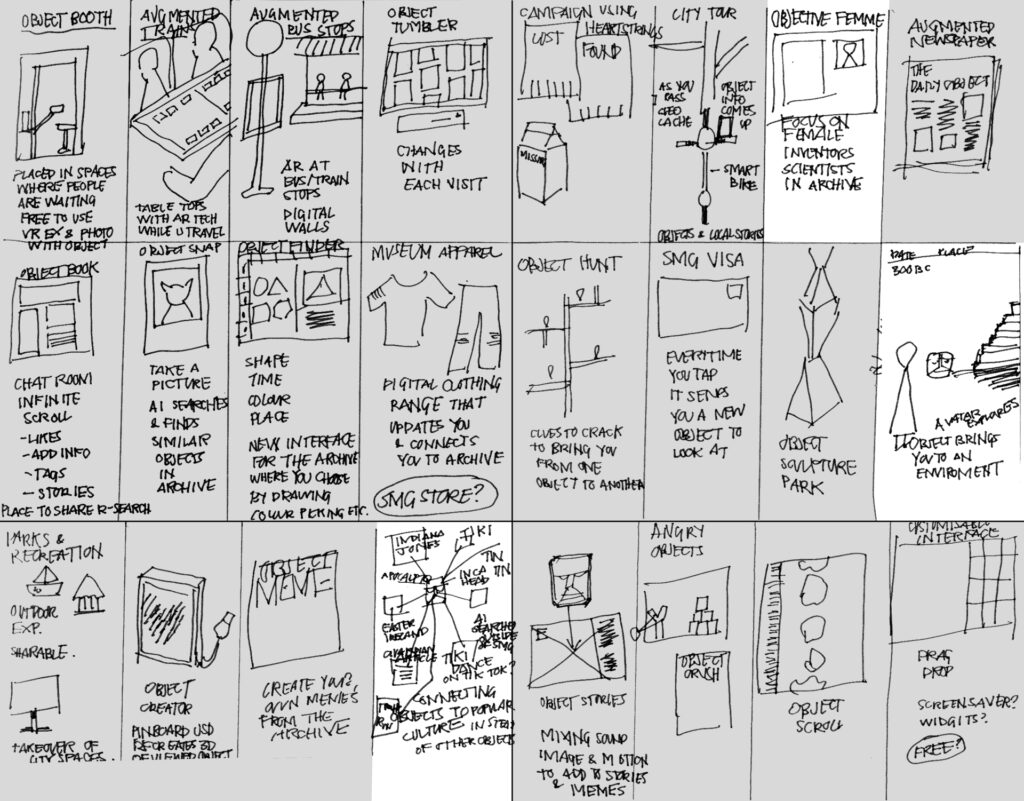
In reviewing the sketches I have highlighted 3 that I think have legs and will look for further feedback from my peers.
They are:
1) To focus on female scientists, inventors etc on the site to bring to the fore women's role in the changing world and the objects and inventions created.
2) To create object experiences. I.E: When you select an object it is placed in context of place and time. Using an avatar you can explore the space and find similar objects of the particular place and time frame.
3) Using AI object selection goes beyond the SMG archive and links to popular culture where you can explore a timeframe or object through articles, performance, books and film.
These have to answer some specific questions I have for myself based on a tutorial with Harriet.
These are:
— Will my audience want to interact with the proposed site ideas?
— Will the proposed site ideas create something worth talking about?
— What's socially shareable?
— Is there a hook that will keep people coming back to the archive with my proposed site ideas?
— Can I bring the joy of discovery into the proposed site ideas?
— Or are they boring and vanilla.
I will ask my peers for further feedback on the ideas wall.
—
THE IDEAS WALL
Generally a great response to my crazy 25. Christina and Tove both seem drawn to the idea of bringing women's stories to the fore within the archive and James agrees that the site should work beyond it walls to have a lasting response from the audience.
In researching the archive further I found a disparity between the male bio's and stories told vs those of the women and feel that the balance needs to be redressed.
DDB Germany created a great campaign to highlight women's forgotten or ignored roles in SMET and culture itself (see below) and I think this is the level of thinking that a project like this requires.


—
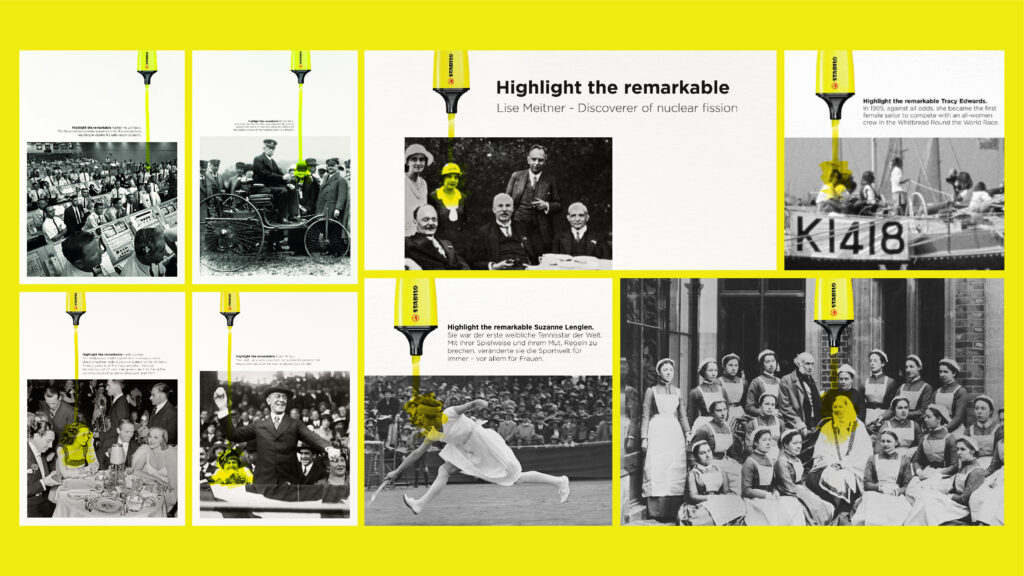
—
After a tutorial with Stuart and my own deeper investigation into the representation of Women both in objects and bio's on the archive I have decided to combine both my idea of highlighting women's achievement of all races and linking this with time frames and popular culture. I am frankly disgusted by the lack of due care taken by the archive to support the achievements of women within the archive. I.E: If you search Marie Curie or Hedy Lamarr there is nothing listed as to their achievements and only pictures. Compare this to Issac Newton and you will understand my own frustration. I want to enable users to suggest objects and women to be included and redress the balance as well as highlight the many achievements by women of colour.
—
REFINING THE CONCEPT
Post the meeting with Stuart and based on feedback from my peers I pushed to further refine the concept…
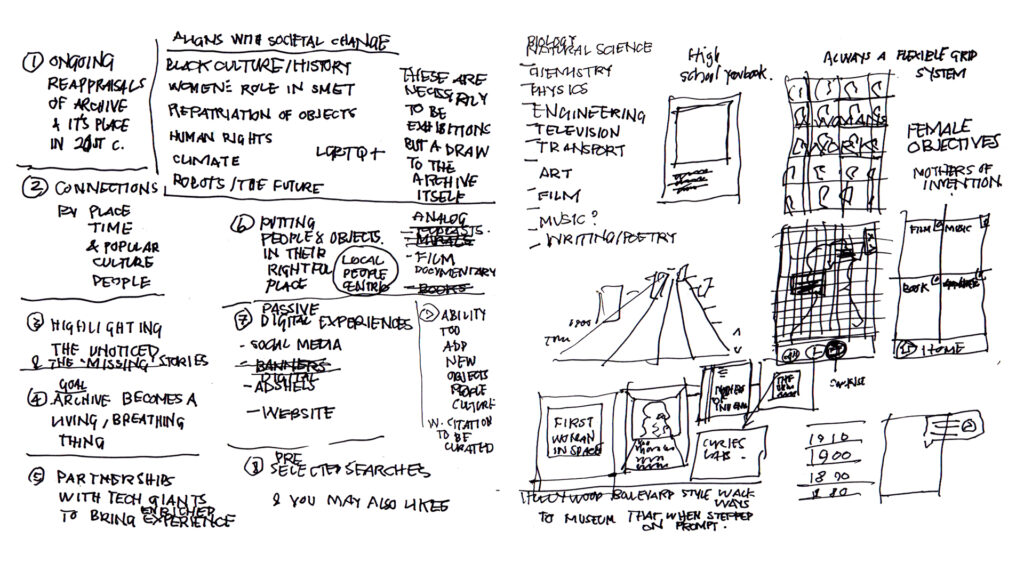
Post development, I see the object archive as a living breathing thing and intend to use it as such, bringing life to contemporary social concerns through people, place, time, and linking this with popular culture to make the archive part of peoples daily lives. By linking the archive (dusty and old) to popular culture (shiny and new) as well as STEM futures I hope to create habit loops where people return not just for information relating to the archive but as a lifestyle platform of choice.
Starting with a focus on women's role in SMET, I intend to redress the balance of the archive and bring to the fore the achievements of women and to tell their stories. This will be called 'Mothers of Invention'.
People will find the archive by intrigue through social media channels, web browsers, digital posters and interactive environmental experiences. Using technology passively - I.E: No prompts, just suggestions in feeds based on cookie data and intriguing graphics, hopefully the footfall to the archive will grow with the reward being a movie, book suggestion, event or new piece of music to listen to based on the search.
I am going to refine this further to ensure the direction for the creative.
—
Select one initial design concept, which you think will successfully answer your chosen project brief. Announce your preferred concept on the Ideas Wall.
CONCEPT DIRECTION/REFINEMENT
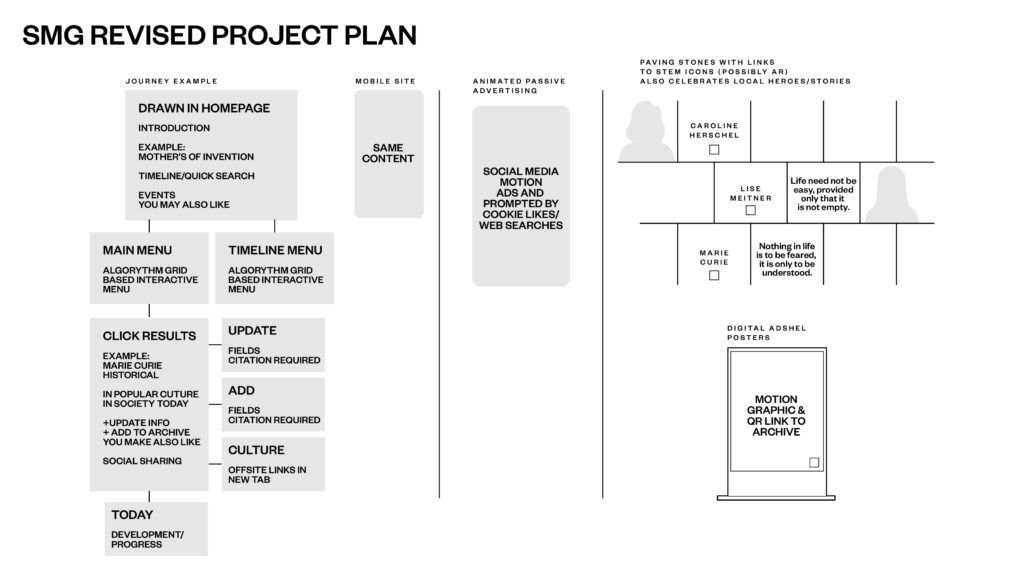
I have revised my overall approach taking into account both interactive (web) processes, digital animations (Social media/environmental graphics) and analogue approaches (environmental). I will further explore and build on this but essentially this is the direction I would like to take the project in. I am keeping my approach fairly simple - not because it is safe or easy but in my own research, complex interfaces are very often kept simple to encourage user participation.
—
Research design thinking, potential formats (print, digital, environmental), traditional and new media, emerging technology and innovative production methods to gain a fresh insight into your project direction.
Add relevant company and project links to the Ideas Wall and upload a post onto your blog to evaluate how your research will help gain a fresh insight into your project plan and help reach your target audience.
I looked at the Google Experiments site as suggested by Stuart in my tutorial, which is awe inspiring. I was particularly taken with two of the experiments within the site in terms of their menu systems. These were the British Museum's 'Museum of the World's' timeline and the main interface for 'Runway Palette'.
Studio Dunbar's work on digital signage in environmental spaces is also exciting, as is the work of Universal Everything, who have developed and implemented motion capture wall's for public interactive participation. It is interesting that the work is displayed either within a space such as an airport, train station, shopping centre or on large digital billboards as these are areas where, as John referred to earlier, people are waiting around or passing through meaning that you have a fairly captive audience.
I have edited these together in a short video as I think they are best shown digitally and in motion rather than as static pieces.
I was playing with some basic face recognition technology to bring photo's to life which I also think could be used in the final project in some way. Maybe as digital posters where the eyes follow you haha…
Loving this screen interaction from Accept and Proceed (Retrieved from: https://www.acceptandproceed.com/project/designmuseum). I had a similar idea of using a grid for my screen animations which will work both online and within environmental spaces. I am not sure yet whether these will have elements of motion capture but it could be fun to make the eyes of an image follow you as you pass by. This bringing to life of historical images makes me think of the motion in Harry Potter where the pictures on the walls interact with the actors. The only thing I want to avoid here is making the animations feel creepy.
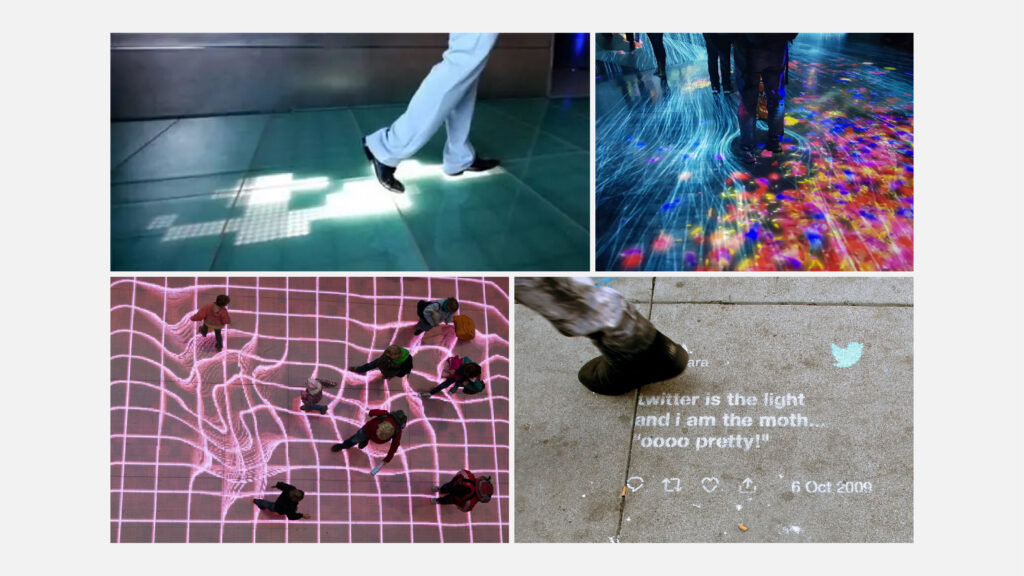
In researching digital or analogue approaches in environmental spaces there are a number of ways to apply graphics to the physical environment. Motion capture, interactive projections and digital walkways are all interesting approaches that unfortunately require a lot of infrastructure and testing in the space to get them to work effectively. For the most part they also only seem to work in light controlled areas or at night. Perhaps this is something that could be implemented as an idea when queuing to get into a museum or within the museum space itself should the project extend to installations. More analogue approaches involve guerrilla marketing tactics such as pavement stencilling although in conducting deeper QR codes don't work when placed on such a textured surface and can't be created using stencils.
Digging deeper into digital trends for 2022 it appears that some of the things people have been interacting with for while now are still relevant and are viewed as non-intrusive uses of passive technologies to engage and grow user engagement.
According to SingleGrain.com, video marketing is one of the most important trends today and likely to be for the next 5-10 years. A Biteable survey found that:
60% of businesses use video as a marketing tool
61% of marketers see video as a “very important or extremely important” part of their marketing strategy
74% say video has a better return on investment than static imagery
52% say that video helps them build trust with potential customers
This coupled with the use of podcasts creates an omnichannel experience where the user comes to you to engage rather than you having to intrude on a person's daily life or space. People like listening to podcasts, whether they are from individuals or companies. One source indicates that 80% of people will listen to most of a podcast episode and stats show that brands using three or more channels in an automation workflow can generate great results:
Engagement rate: 18.96% on omnichannel vs. 5.4% on single-channel
Purchase frequency: 250% higher on omnichannel vs. single-channel
Average order value: 13% more per order on omnichannel vs. single-channel
Customer retention rates: 90% higher for omnichannel vs. single-channel
There are also some interesting developments where phone camera technology can be used to upload an image into search which could be interesting for a project like this. There are two companies that are leveraging visual search:
A) Pinterest
Pinterest’s Lens recognises 2.5 billion objects and has inspired over 600 million searches on Pinterest’s mobile apps and browser extensions. Since its launch, they have seen a 140% growth in usage.
B) Google Lens
Google Lens is a visual search engine by Google, which recognizes objects and landmarks through a camera app. Here’s some of the examples of what you can do when you take a photo of the following items:
Book: Get a summary and read reviews.
Event flyer or billboard: Add the event to your calendar.
Landmark or building: See historical facts, hours of operation, and more.
Painting in a museum: Read about the artist and learn more.
(Retrieved from: https://www.singlegrain.com/digital-marketing/digital-marketing-trends-2021).
(Retrieved from: https://esidesign.nbbj.com/transforming-places-into-experiences-trends-for-2020)
INSIGHTS
— Rich content based interfaces create make a stronger personal connection and discovery platform.
— Analogue connections can be made through omnichannel marketing such as video content and podcasts.
— Image capture is a personalised way of connecting audiences to the object archive.
— Captive lifestyle audience environments when travelling and shopping can be utilised to create digital motion and interactive experiences.
—
Develop your design concept and post your innovative design thinking on your blog. Add a blog link onto the Ideas Wall, for peer discussion.
Below: Starting to flesh out the concept thinking about the content and functionality of the site, how the site will be found externally though omnichannel marketing and using open spaces to bring in some of the graphic experiences. What you see here is not design but more of a wire frame of the site, site advertising and use of public space. I am seeking to broaden my thinking beyond what you see here but this is the jumping off point.
